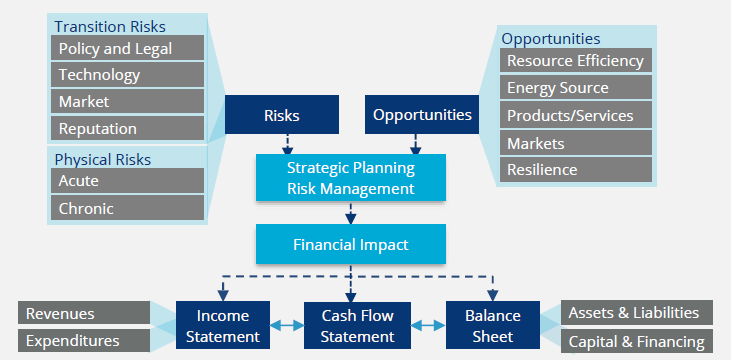Task Force on Climate-related Financial Disclosures (TCFD)
Summary
In December 2015, the Financial Stability Board (FSB) launched the industry-led Task Force on Climate-related Financial Disclosures (TCFD) to develop recommendations on climate-related financial disclosures after the G20 Finance Ministers and Central Bank Governors asked FSB to review how the financial sector can take account of climate-related issues in April 2015.
In June 2017, TCFD published the final report, the practical guidance on climate-related financial disclosures, and technical guidance on climate-related scenario analysis, which forms climate-related financial disclosure framework.
In September 2018, 513 organizations expressed their support for the TCFD. For more information, click here (https://www.fsb-tcfd.org/tcfd-supporters/)
Climate-related financial disclosure framework
- The final report explains climate-related risk, opportunities and their financial impact as per the below chart and then, shows voluntary, consistent climate-related financial disclosure framework for use by companies in providing information to investors, lenders, insurers, and other stakeholders, providing 4 recommendations and 11 recommended disclosures.
- ⇒ Useful link①


- Climate-related scenario analysis
As for c) of "Strategy" shown in Chart 2, which is "describe the resilience of an organization's strategy, taking into consideration different climate-related scenarios, including a 2° Celsius or lower scenario," this is one of the TCFD's key recommended disclosures. Technical supplement provides guidance on climate-related scenario analysis. - ⇒ Useful link②
Opportunities for Companies
TCFD's climate-related financial disclosure framework enables companies to provide climate-related financial information investors, lenders, insurers, and other stakeholders based on their needs.
It also enables companies to deliver a message such as their resilience against climate change widely.
Recommended Actions for Companies
To make disclosure on climate-related financial information based on the TCFD disclosure framework in annual financial fillings.
To make such disclosure in official corporate reports, if the TCFD framework is not consistent with the requirements of national financial fillings.
The current situation on climate-related financial disclosure
The 2018 status report (https://www.fsb-tcfd.org/publications/tcfd-2018-status-report/) published by TCFD shows information such as current disclosure practices relative to core elements of the recommended disclosures.
According to the report shows key findings including "the majority disclose some climate-related information," "Financial implications are often not disclosed," and "Information on strategy resilience under climate-related scenarios is limited"
Useful link
| Document | Preparer | Contents |
|---|---|---|
| ① Final Report Recommendations the Task Force on Climate-related Financial Disclosures, June 2017 (https://www.fsb-tcfd.org/wp-content/uploads/2017/06/FINAL-2017-TCFD-Report-11052018.pdf) |
TCFD | It shows the TCFD's climate-related financial disclosure framework by providing information including recommendations, recommended disclosures and guidance on it. |
| ② Annex: Implementing the Recommendations of the TCFD (June 2017) (https://www.fsb-tcfd.org/publications/final-implementing-tcfd-recommendations/) |
TCFD | It provides detailed guidance on the TCFD's climate-related financial disclosure for all sectors as well as for each sector*. *Financial sector (bank; insurance company; asset owner; asset manager), Non-financial sector (Energy; Transportation; Material and Buildings; Agriculture, Food and Forest Products) |
| ③ Technical Supplement: The Use of Scenario Analysis in Disclosure of Climate-related Risks and Opportunities (June 2017) (https://www.fsb-tcfd.org/wp-content/uploads/2017/06/FINAL-TCFD-Technical-Supplement-062917.pdf) |
TCFD | It provides the guidance on climate-related scenario analysis recommended in ① |
